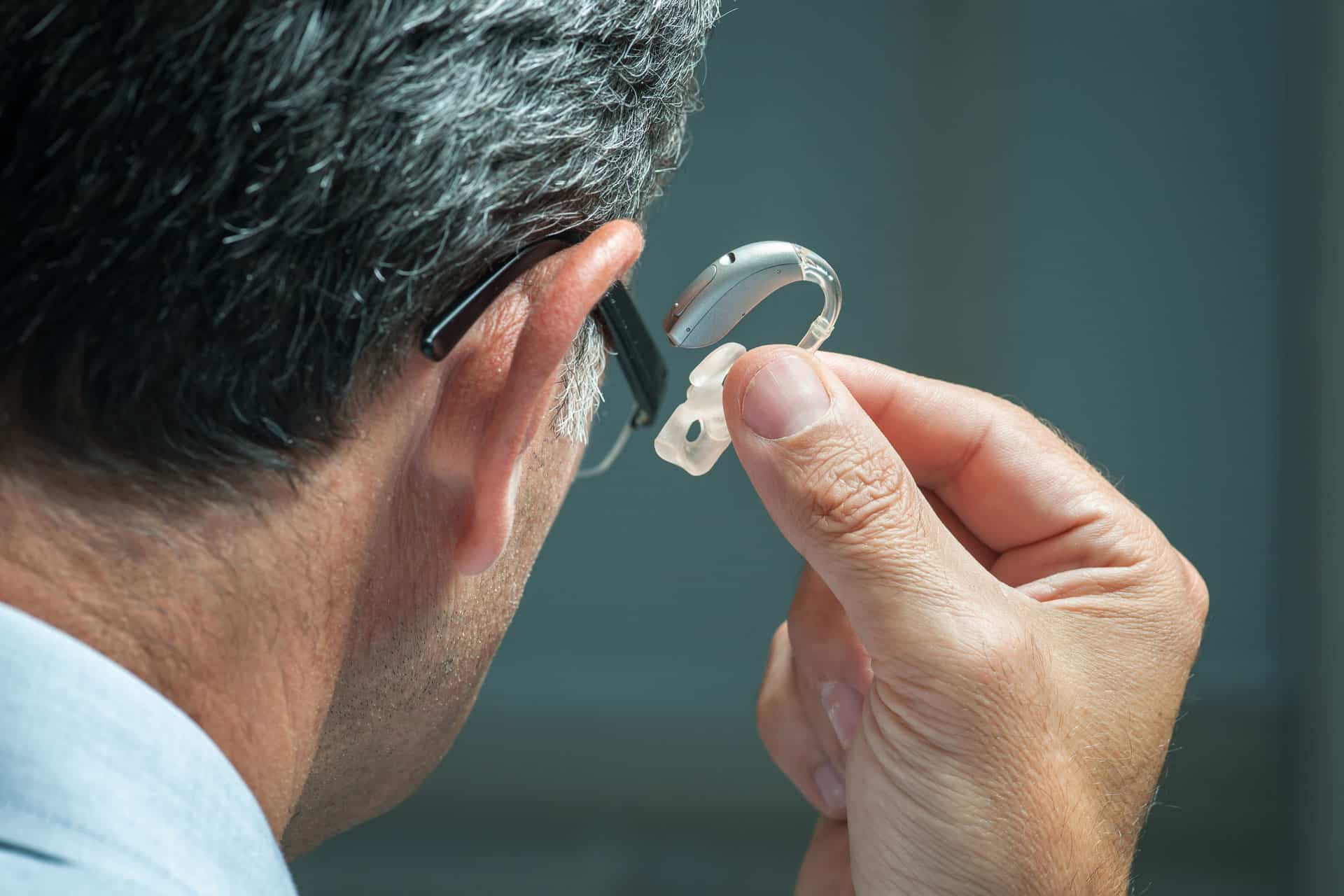Delivery in 2-3 working days
Hearing aids
A guide to better hearing
Modern technology has made it possible to overcome numerous challenges that affect our quality of life. Hearing aids are a prime example of such breakthroughs that have improved the lives of millions of people worldwide. Hearing aids are devices designed to help people who suffer from various forms of hearing loss. These devices significantly improve the ability to hear sounds and speech, making it easier to communicate and interact with the world around us.
This guide is intended to provide a comprehensive introduction to the world of hearing aids, including the different types of hearing aids, how they work, and the benefits they offer for improving hearing and overall quality of life.

What are the different types of hearing aids?
There are a variety of hearing aid types and designs from different manufacturers, each tailored to specific needs and situations. These include requirements related to the degree of hearing loss, different lifestyles and the individual preferences of users:
Behind-the-ear (BTE) hearing aids
BTE hearing aids are designed to be positioned behind the auricle. From there, they transmit sound signals directly into the ear canal. This type of hearing aid is often the preferred choice for people facing severe hearing loss. They offer high performance and are capable of compensating for a wide range of hearing losses. Although they may be less aesthetically pleasing to some users due to their size and visibility, they are typically easier to use, especially for those with limited dexterity.
In-the-ear (ITE) hearing aids
Unlike BTE devices, ITE hearing aids are smaller and are placed directly in the external ear canal or pinna. They are more discreet than their BTE counterparts and are often preferred by people who want a less noticeable hearing aid. ITE hearing aids are well suited for people with mild to moderate hearing loss. They also offer more natural sound quality because they pick up sound directly in the ear. However, their small size and positioning in the ear can make maintenance and cleaning a bit more challenging.
In-the-Hearing (IgH) Hearing Aids
IgH hearing aids are even smaller than the ITE devices and are inserted directly into the ear canal. Due to their position, they are almost invisible and therefore particularly popular with users who place great value on discretion. In addition, due to their proximity to the eardrum, they offer a natural hearing experience, as they use the body's own ability to localize sound. It should be noted, however, that due to their small size and the fact that they are positioned deep in the ear canal, these devices are not suitable for every hearing loss and require regular professional maintenance.
Cochlear Implants
For individuals for whom conventional hearing aids are not sufficient because they suffer from very severe hearing loss or deafness, cochlear implants may be a suitable option. A cochlear implant is an electronic medical device that replaces the function of the damaged inner ear to send sound signals directly to the auditory nerve.
This device consists of two parts: an outer part that is worn behind the ear and picks up sound signals, and an inner part that is surgically inserted into the ear and converts these sound signals into electrical impulses. These impulses are then sent to the auditory nerve, which transmits them to the brain, where they are perceived as sound.
Cochlear implants can help significantly improve speech intelligibility and may even help people who are completely deaf to hear sounds again. However, they require surgery and intensive follow-up care and rehabilitation to train hearing and speech intelligibility. Therefore, they are usually used only in cases where conventional hearing aids are inadequate or ineffective.
How do hearing aids work?
Hearing aids pick up sound signals with a microphone, amplify these signals with a speaker, and then direct them into the ear canal. In this process, sounds and speech are transmitted directly into the ear canal through an earmold, also called an earpiece or sound tube, to improve clarity and understanding of speech. However, this description is quite simplistic. In fact, behind the way hearing instruments work is a much more complex technology that involves individual fittings and special features tailored to the user's specific hearing needs.
The process begins when the hearing aid's microphone picks up sound waves from the environment. This sound can include speech, music, background noise and all kinds of sounds that we perceive in our daily lives. This captured acoustic signal is then converted into a digital signal.
The next step takes place in the part of the hearing aid called the amplifier. Here, the digital signal is amplified, i.e. made louder, before it reaches the speaker. In modern digital hearing aids, however, the amplifier can not only make the signal louder, but also selectively amplify certain frequencies that the user hears less well and amplify other frequencies less that the user hears better. This allows the hearing aid to be customized to the user's specific hearing profile.
Another key element of modern hearing systems is the digital signal processor (DSP). This can modify the digital signal in a variety of ways to improve sound quality and reduce background noise. This can include techniques such as noise reduction, feedback suppression or directional microphone technologies.
Once the signal has been processed and amplified, it is converted back into sound waves by the hearing aid's loudspeaker and transmitted into the ear canal via the earmold. There it is perceived as sound by the eardrum and transmitted to the brain, where it is interpreted as information.
What functions do modern hearing aids offer?
Modern hearing aids are no longer just simple sound amplifiers. They are now sophisticated, intelligent devices equipped with a range of additional features designed to provide users with an enhanced listening experience and added comfort. Some of the advanced features you can find in modern hearing aids include:
Bluetooth connection:
Many of the latest hearing aids offer the ability to connect wirelessly to other devices, such as your smartphone. This Bluetooth connection not only allows you to take phone calls directly through your hearing aid and listen to music in high quality, but also to access a variety of apps. These apps can help you customize your hearing aid settings, change listening programs, or even track listening data to optimize your hearing performance.
Rechargeable batteries:
In the past, hearing aids often required the regular replacement of small batteries. Now, many models have built-in rechargeable batteries. These can be conveniently recharged overnight, so you have steady and reliable performance throughout the day without worrying about changing batteries. This is not only more environmentally friendly, but also more practical and cost-effective for users.
Hearing protection:
Some advanced hearing aids have special features designed to protect your residual hearing. They can automatically attenuate very loud sounds to protect your ear from possible damage. At the same time, they can amplify very soft sounds to give you a balanced listening experience. This type of dynamic sound adjustment allows you to hear clearly in both quiet and noisy environments.
Fall detectors:
Safety features such as fall detectors are built into some of the latest hearing aid models. These devices can detect when you fall and automatically send an alarm to a preset contact. This provides additional safety and peace of mind, especially for the elderly or people with limited mobility.
Tinnitus masker:
For people who suffer from tinnitus, hearing aids with built-in tinnitus maskers can be a great help. This feature produces a soothing, neutral sound that can mask the annoying whistling or buzzing of tinnitus. This can help reduce the impact of tinnitus on quality of life and promote concentration and relaxation.
In addition to hearing aids, there are other special hearing aids, aids and technology for the hearing impaired that create an improved hearing experience, especially in conjunction with hearing aids. These include the OSKAR TV hearing amplifier from faller audio.
While hearing aids amplify everything when watching TV, i.e. both speech and ambient noise, the portable TV speaker improves the TV sound and filters out distracting noises at the same time. This means that dialog and speech on TV can be understood clearly and distinctly again, even with hearing aids.
How do I choose the right hearing aid?
Since hearing aids are tailor-made solutions for individual hearing problems, comprehensive and detailed advice from a hearing care professional is essential. When choosing the appropriate hearing aid, several factors should be considered that go far beyond mere technical functionality. These include:
The degree of hearing loss:
This is a crucial factor when selecting a hearing aid. A mild hearing loss requires a different type of support than a moderate or severe hearing loss. Your hearing care professional will be able to perform an accurate hearing evaluation to determine the degree and type of hearing loss you have. Based on this information, you can work together to select the most appropriate hearing aid.
Your budget:
Hearing aids are available in a variety of price ranges, from basic models to state-of-the-art premium devices. It is important to find a hearing aid that fits both your budget and your hearing needs. Possible financing options, such as through your health insurance, may also play a role.
Your aesthetic preferences:
Although functionality is paramount, the appearance of the hearing aid can be a deciding factor for many people. Some prefer a small, barely visible device, while others may feel more comfortable with a visible model. Again, your personal preferences should factor into the decision.

What do hearing aids cost and does health insurance cover the costs?
The cost of hearing aids can vary greatly depending on the specific features and technology built into each device. There are simple, basic models available for a few hundred euros. On the other hand, there are high-end devices with advanced features such as Bluetooth connectivity, background noise cancellation, artificial intelligence and other technologies, which can often cost several thousand euros.
Most public health insurers in Germany cover a fixed amount for hearing aids, which helps to cover the costs. However, this fixed amount may change depending on individual needs and the specific hearing impairment. In addition, some private health insurers may cover a larger portion of the cost or even cover the full cost of high-quality devices.
It is important to note that many hearing aids are available to insured persons at zero cost. This means that insured individuals do not bear any direct costs, as the health insurance company covers the majority of the costs. However, a co-payment may be required if the hearing aid selected goes beyond basic features and provides additional features not covered by health insurance.
Where to buy a hearing aid?
You can purchase hearing aids from a hearing care professional. These experts perform hearing tests, advise you on choosing the right device and fit it to your ear and hearing needs.



